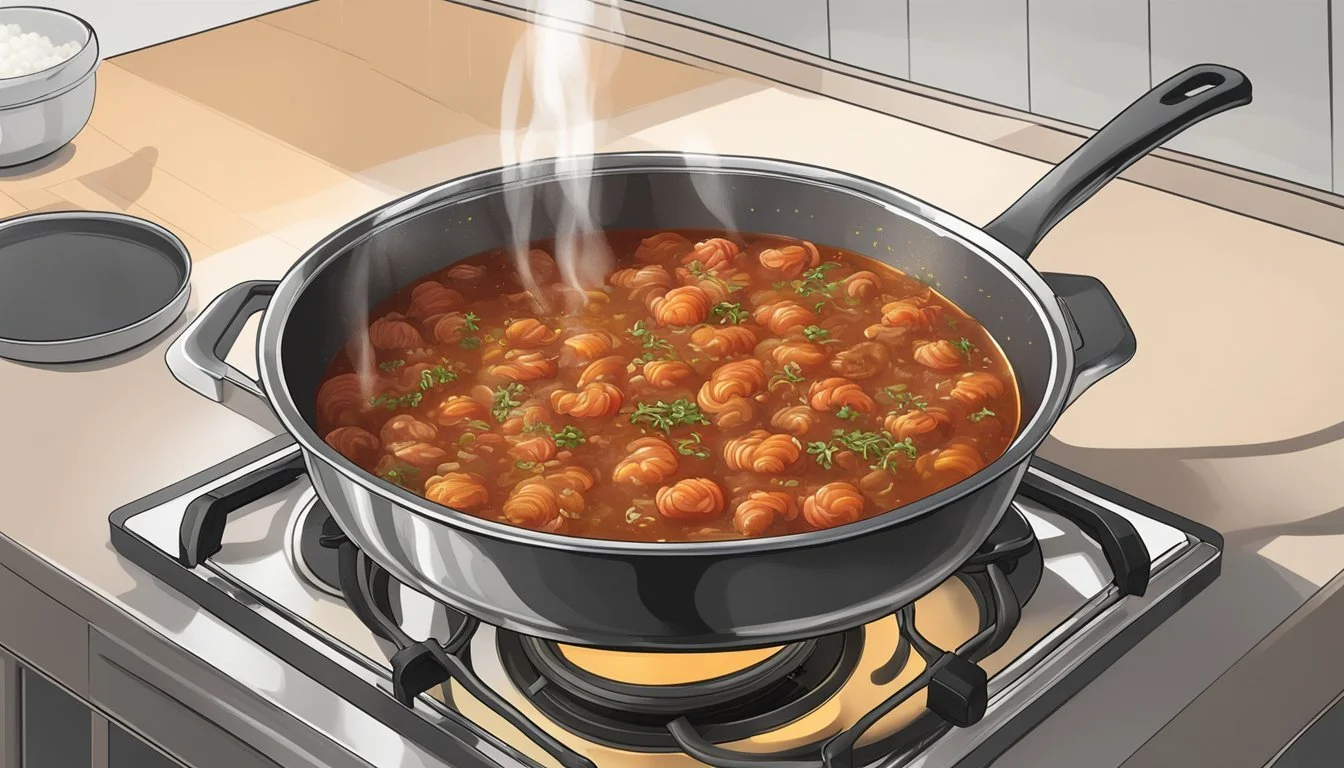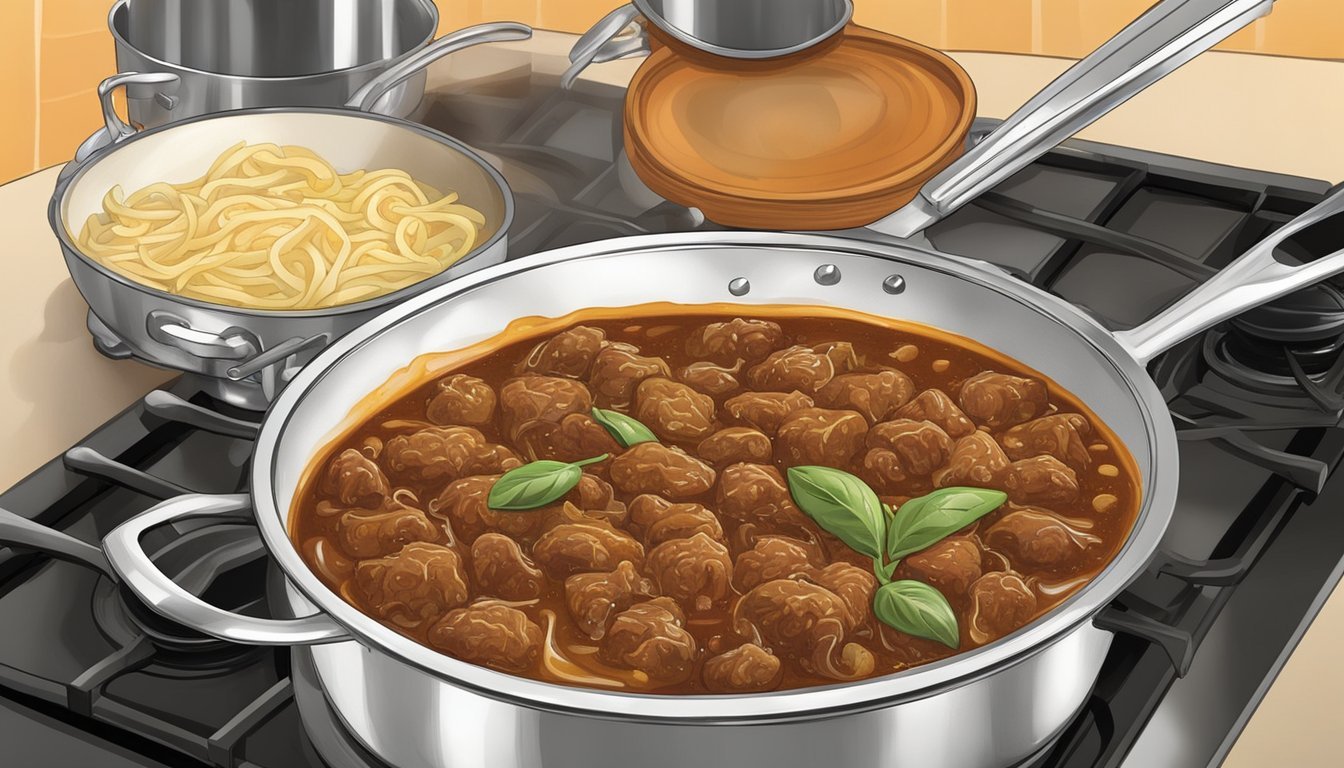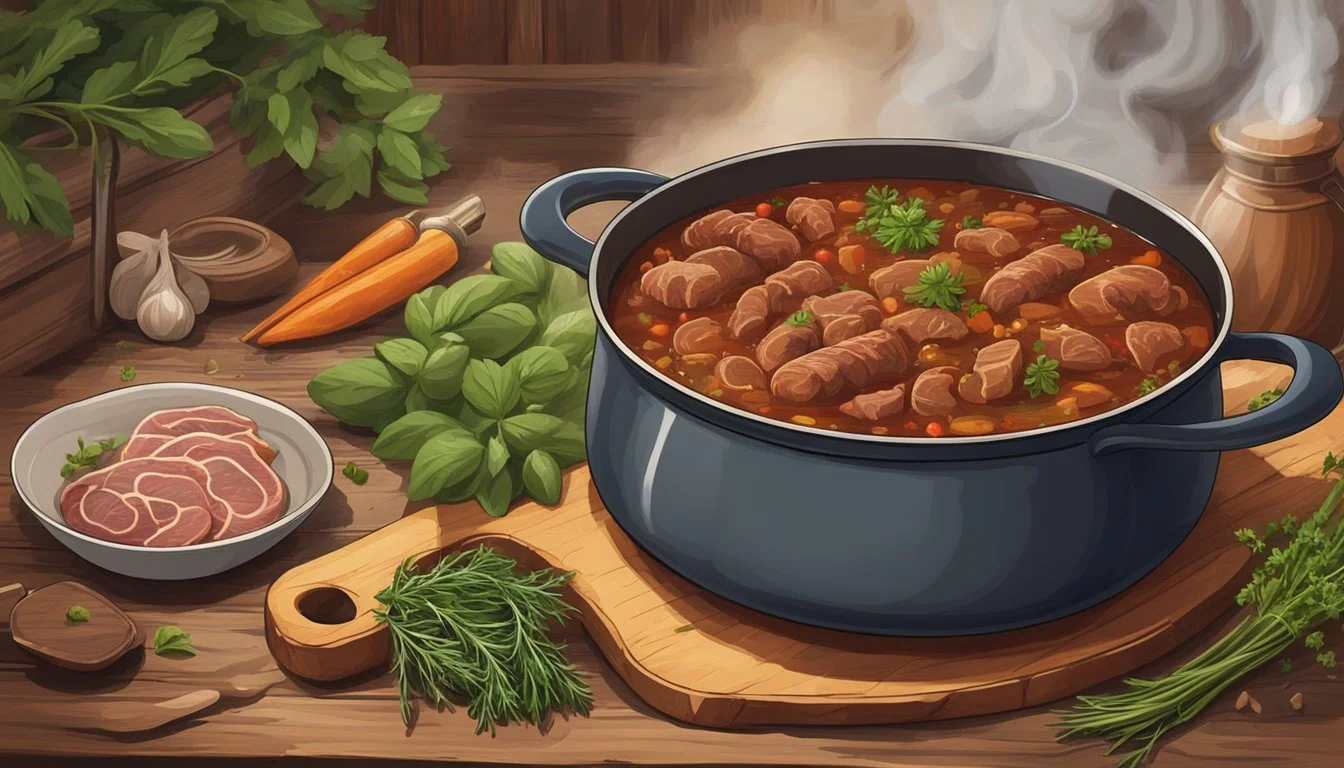Best Way to Reheat Beef Ragu
Tips for Preserving Flavor and Texture
Beef ragu is a rich and hearty dish that is loved for its depth of flavor and tender meat. When reheating beef ragu, it's important to do so in a manner that maintains its succulent taste and preserves the moist texture of the beef. The key lies in a slow and gentle reheating process to ensure that the flavors are not only retained but further amalgamated.
In order to safeguard the integrity of the dish, it is essential to consider the components of beef ragu. The dish typically consists of a well-balanced mixture of beef, vegetables, and a robust tomato-based sauce. An effective reheating method needs to account for the delicate balance between these elements to prevent any one component from overpowering the others or from becoming overcooked.
The methods of reheating beef ragu are varied, yet each one should focus on uniform heat distribution. Whether using a stovetop, oven, or slow cooker, the goal is to reheat the ragu slowly, which helps in preserving its complex layers of flavor and preventing the meat from drying out. This gentle approach ensures that the dish retains its characteristically deep and rich flavor that fans of beef ragu have come to savor.
Understanding Beef Ragu
Beef Ragu is a classic Italian sauce deeply rooted in tradition. It is recognized by its rich taste, characterized by a concentration of flavors developed through a slow-cooking process.
Historical Significance
Beef Ragu has been a staple in Italian cuisine, with variations tracing back centuries. Originally, ragu was a technique for cooking tough cuts of meat to tender perfection. It's a celebration of patience and culinary skill, transforming simple ingredients into a comforting and hearty meal.
Primary Ingredients
The foundation of a beef ragu lies in its quality ingredients. Typically made with beef chuck roast, a protein well-suited for slow cooking, the dish is enriched with a mélange of carrot, celery, onion, and garlic, all sautéed in olive oil to build flavor. Tomato paste and liquids such as beef broth or beef stock, and often red wine, are used to deepen the ragu's complexity and add a robust, rounded taste.
Styles of Beef Ragu
Variations of beef ragu can be found across different regions. While traditional recipes might incorporate pancetta for an extra layer of flavor, modern adaptations may substitute it with other ingredients or omit it entirely. The sauce is known for its versatility, as it pairs well with a variety of pastas (What wine goes well with pasta?) and breads. However, the essence of beef ragu is its slow-cooking process, ensuring the beef chuck roast is tenderly shredded into the rich, aromatic beef ragu sauce that has become a beloved comfort food worldwide.
Pre-Reheating Preparation
Before reheating beef ragu, proper preparation can ensure that its richness and depth of flavor are preserved. The keys to successful reheating lie in how the ragu is stored, thawed, and adjusted for consistency.
Storage Tips for Ragu
To maintain the quality of beef ragu, it should be stored in an airtight container to prevent freezer burn and moisture loss. If freezing, ensure the ragu cools down to room temperature before placing it in the freezer. Adding a thin layer of olive oil on top can act as a barrier against air and help preserve the tomato sauce's moisture and flavor.
Room Temperature Cooling Duration: 30-60 minutes
Airtight Container Specification: Freezer-safe, with minimal headspace
Thawing Beef Ragu
When ready to reheat, thawing beef ragu properly is crucial. The ragu should be transferred from the freezer to the refrigerator well in advance (preferably overnight) to allow for gradual defrosting. If a quicker method is needed, placing the sealed container in cold water can expedite the process, but never thaw ragu at room temperature as it can compromise food safety.
Refrigerator Thawing Time: 24 hours
Cold Water Thawing Time: 2-3 hours
Ragu Consistency Adjustment
Upon thawing, the consistency of the ragu may require adjustment if it appears too thick. Gently reheating the ragu while slowly stirring in a little pasta water or additional tomato sauce can help restore its original texture. Remember to keep the heat low to avoid altering the complex flavors of the ragu.
Consistency Adjustments:
Pasta Water: Add in small increments, stirring continuously.
Tomato Sauce: Use sparingly to avoid diluting flavors.
Reheating Techniques
Selecting the appropriate reheating method is crucial for preserving the richness and depth of flavor in beef ragu. It is important to consider the equipment available and the amount of time one has for reheating.
Oven Method
Preheat the oven to 325°F (165°C). Place the beef ragu in an oven-safe dish, ideally a Dutch oven, and cover tightly with foil to retain moisture. Reheat the ragu for 20-25 minutes, checking occasionally. If the ragu appears dry, a small amount of stock can be added to ensure it remains moist.
Stovetop Method
This method allows for more control and can enhance the ragu's flavor. In a pot or Dutch oven, simmer the ragu over medium-low heat, stirring occasionally. If the sauce thickens too much, one can add a little water or stock to adjust the consistency.
Microwave Method
For reheating smaller portions, the microwave can be convenient. Place the beef ragu in a microwave-safe container, partially cover with a lid or microwave-safe wrap to allow steam to escape, and heat on medium power. Stir the ragu at 30-second intervals to ensure even heating and to maintain texture.
Slow Cooker Approach
Using a slow cooker or crockpot can evenly reheat beef ragu without the risk of drying it out. Set the slow cooker to a low heat setting and allow the ragu to slowly come to temperature, which may take a couple of hours. Stir occasionally, and if needed, add a splash of water or broth to preserve the moisture.
Preserving and Enhancing Flavors
When reheating beef ragu, it is essential to not only preserve the existing flavors but to also enhance them. Subtle nuances from the herbs and spices should be carefully considered to achieve a vibrant and well-rounded dish.
Adding Fresh Herbs and Spices
To infuse freshness into the beef ragu, one can introduce fresh herbs during the reheating process. This adds a new dimension to the flavor profile. Bold usage of herbs should be balanced, ensuring they complement rather than overshadow the core flavors of the ragu.
Basil: Provides a sweet, peppery layer that ideally suits tomato-based sauces.
Thyme: Delivers a subtle earthy tone that pairs well with the richness of the ragu.
Oregano: Offers a robust, slightly bitter taste that can enhance the meaty flavors.
Bay Leaves: Impart a floral and slightly minty essence, perfect for deepening the ragu's complexity.
Incorporating a mix of these herbs can rejuvenate the ragu. For instance, adding a sprig of thyme or a fresh bay leaf can provide a burst of aroma that echoes the initial cooking process. Similarly, a final garnish with chopped basil can add a fresh burst of flavor.
Fresh herbs should be used judiciously as their flavors are more pronounced. They can be stirred into the ragu toward the end of the reheating process to preserve their vibrant taste and aroma. Additionally, a dash of Italian seasoning can harmonize the individual flavors, melding them into one cohesive profile.
If the ragu seems slightly reduced or concentrated after storage, one might consider a splash of red wine to reintroduce some of the lost acidity and fruitiness. Moreover, a touch of tomato paste can add color and intensity, bringing the sauce closer to its original state. The chef's confidence in these methods stems from understanding how these ingredients interact with one another, ensuring the beef ragu served is as rich and flavorful as when it was first prepared.
Serving Suggestions
When reheating beef ragu, the final presentation can enhance the dining experience. Pairing the rich and flavorful ragu with the right accompaniments turns a simple reheated meal into an impressive dish suitable for a family dinner or entertaining a crowd.
Pairing With Pasta
The heartiness of beef ragu pairs exceptionally well with pasta that can hold onto the sauce. One should opt for thicker, ribbon-like pastas such as pappardelle or tagliatelle to support the weight and texture of the sauce. Alternatively, rigatoni with its ridges, or ravioli that can be filled with cheese or vegetables, are excellent pasta choices that complement the thickness of a beef ragu.
Suitable Side Dishes
The rich taste of beef ragu demands side dishes that balance the meal without overpowering it. A fresh green salad dressed lightly with vinaigrette provides a crisp contrast to the hearty ragu. For a more indulgent side, roasted or steamed vegetables seasoned with herbs can complement the depth of flavors in the beef ragu.
Garnish Recommendations
A final touch of freshly grated Parmesan cheese adds a salty, nutty flavor that enhances the ragu. A sprinkle of freshly chopped herbs such as parsley or basil not only adds a pop of color but also a fragrant note to the dish. These garnishes should be applied after reheating and just before serving to preserve their textures and flavors.
Tips for Leftovers
Properly dealing with beef ragu leftovers is critical to maintaining the dish’s richness and depth of flavor. Ensuring the shelf life is maximized and reusing the leftovers creatively can transform the beef ragu experience.
Maximizing Shelf Life
To maximize the shelf life of beef ragu, they should promptly store it in airtight containers within two hours of cooking. For refrigeration, beef ragu can last up to 4 days. When freezing, it is best to portion the ragu into usable quantities before freezing to avoid thawing more than needed. Beef ragu will maintain its best quality for about 2-3 months in the freezer, but remains safe beyond that time. Reheating should be done slowly and thoroughly to preserve its moisture and flavor; using a pan over low heat is advisable.
Refrigerate: Within 2 hours of cooking, in airtight containers, up to 4 days.
Freeze: Use freezer bags or airtight containers; label with the date.
Duration: 2-3 months for best quality.
Tip: Portion it before freezing.
Creative Use of Leftovers
When it comes to beef ragu leftovers, the options extend beyond simply reheating and serving with pasta. For a creative twist, one could incorporate the leftovers into a lasagna, adding layers of richness to the dish. Alternatively, mixing the beef ragu with cooked rigatoni, topping with cheese, and baking until bubbly transforms it into a comforting baked pasta meal. The key is to gently reheat to maintain moisture and prevent the meat from drying out.
Transform into Lasagna: Layer ragu with pasta sheets, béchamel, and cheese.
Baked Ragu Pasta:
Mix with rigatoni or other pasta.
Top with cheese.
Bake until cheese is melted and bubbly.
Troubleshooting Common Issues
When reheating beef ragu, one might encounter issues that can affect the dish's richness and savory depth. This section provides solutions to maintain the desirable tenderness and robust flavor of the ragu.
Preventing Dryness
To ensure the beef remains succulent and juicy during reheating, it's pivotal to reheat slowly and at a lower temperature. Adding a small amount of liquid, such as beef stock or water, can help maintain the tenderness of the beef. Covering the pot or dish keeps the moisture in, preventing the ragu from drying out.
Method:
Add 2-3 tablespoons of beef broth or water.
Cover the pot tightly with a lid or aluminum foil.
Reheat on low heat, checking periodically.
Adjusting Seasoning After Reheating
After reheating, the beef ragu's seasoning may need a slight adjustment. A dash of salt and pepper can enhance the natural flavors of the meat. If the ragu tastes too acidic, a pinch of sugar may balance it out. To enrich its flavor further, a drizzle of olive oil or a spoonful of heavy cream can be stirred in after the ragu is thoroughly heated.
Seasoning Adjustments:
Salt/Pepper: Add to taste
Sugar: A pinch (if needed)
Olive Oil: 1-2 teaspoons
Heavy Cream: 1-2 tablespoons (optional)
When necessary, one may deglaze the pot after reheating to incorporate any flavorful bits stuck to the bottom. This method enhances the ragu's overall savoriness and adds an extra dimension to its taste profile.
Health and Safety Considerations
When reheating beef ragu, one must ensure that the methods employed not only maintain the richness and depth of flavor but also meet critical health and safety standards to prevent foodborne illness.
Proper Food Handling
Temperature control is paramount when handling proteins such as beef chuck roast or ground beef. Beef ragu should be stored at or below 40°F and reheated to an internal temperature of 165°F to ensure safety. This temperature effectively eliminates any potential bacteria. The dish should be consumed or refrigerated within two hours of cooking to maintain safety.
Storage: Refrigerate beef ragu promptly in airtight containers.
Reheating: Use a food thermometer to check that the internal temperature reaches 165°F.
Reheating Guidelines
To keep the beef ragu tender and flavorful, gentle reheating is advisable. The ragu should be heated slowly, avoiding high heat, which can cause the proteins to tighten and become tough.
Oven Reheating: A medium, steady temperature of around 325°F allows for even warming without drying the beef. The ragu should be covered to retain moisture.
Stovetop Reheating: Simmer the ragu over low heat, stirring occasionally. If needed, one may add a small amount of broth or water to maintain the desired consistency and prevent the meat from drying out.
Using these methods, the flavors in the ragu have the best chance of remaining as rich and robust as when it was first prepared.
Beyond Ragu: Exploring Variations
As aficionados of rich meat sauces explore variations beyond the traditional beef ragu, they often encounter an array of equally satisfying options. Each variation offers a nuanced experience that caters to different preferences and dietary restrictions.
Bolognese and Other Meat Sauces
Bolognese is a quintessential meat-based sauce that shares some similarities with ragu but stands out due to its specific preparation and ingredients. It traditionally uses a mixture of meats such as chuck or round roast, finely chopped to achieve a more tender texture. Unlike ragu, which may use larger chunks of meat, Bolognese aims for a finer consistency.
Soffritto forms the aromatic base, commonly comprising onion, celery, and carrots, finely diced and sautéed to perfection.
A hallmark of an authentic Bolognese includes the use of San Marzano tomatoes, praised for their sweetness and strong tomato flavor.
Cooking Bolognese is typically done slowly, allowing the flavors to deepen and meld together over time.
Pot roasts in the American kitchen often translate into a variation of ragu when the leftover meat is repurposed into a rich sauce. For the modern cook, devices like the Instant Pot accelerate the cooking process, providing similar depth of flavor in a fraction of the time.
Restaurant versions of these meat sauces may include varying spice levels; for instance, red pepper flakes are sometimes added for a subtle kick.
Vegetarian and Vegan Alternatives
Vegetarian and vegan variations of ragu cater to those who seek the richness of a meat sauce without the meat. These alternatives typically rely on a foundation of a flavorsome soffritto, building layers of taste that mirror the complexity of their meaty counterparts.
Hearty vegetables like mushrooms, lentils, or chopped nuts can mimic the texture and substance typically provided by meat.
To mimic the umami depth found in traditional ragu or Bolognese, ingredients such as nutritional yeast, soy sauce, or miso paste are often utilized.
These variations harmonize well with the same San Marzano tomatoes, adding brightness and authentic Italian flavor to the sauce.
Whether one opts for a classic Bolognese, leverages the convenience of an Instant Pot, or explores plant-based sauces, each method offers a distinct take on the beloved ragu, expanding the repertoire of robust and flavorful sauces.
Ragu Presentation and Aesthetic
A thoughtfully presented beef ragu not only tantalizes the senses but also enhances the dining experience. Judicious use of parmesan, a precise slicing technique, and the sheen of a rich ragu sauce are key to an appetizing presentation.
Plating Techniques
When plating beef ragu, visual appeal is crucial. One starts by ladling the warm ragu sauce attentively over a bed of freshly cooked pasta, ensuring a generous amount without drowning the pasta. A judicious sprinkle of finely grated Parmesan adds both a flavor enhancement and a pleasing visual contrast.
Spoon Placement: Carefully place one spoonful at a time.
Cheese: Lightly dust with Parmesan, avoiding clumps.
Sauce to Pasta ratio: Aim for a balance where the ragu sauce neither overwhelms nor is too sparse.
Table Setting for Occasions
Beef ragu’s presentation changes with its setting. For intimate occasions, one might opt for warm, earthy tones on the table that reflect the heartiness of the meal. A refined white platter can serve as the backdrop for the ragu, allowing its rich color to stand out. Crushed tomatoes in the sauce should retain some structure, adding to the visual appeal.
Casual Dining: A skillet placed at the center of the table invites a communal feel.
Formal Events: A baking tray is not suitable here; instead, serve individual portions in elegant shallow bowls.





